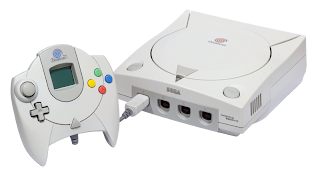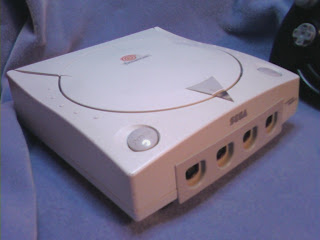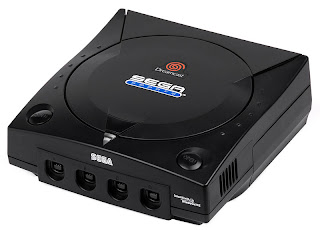This Console is Going to the Grave With Me... I'm Serious.
Review By Claud
1998 was a mystical year: The Yankees won their record 24th World Series (those damn Yankees), Microsoft released the brand new Windows 98, and the Sega Dreamcast was released on the market. The Dreamcast introduced many innovations into the Video Game world, and most were great. We were thrust into the sixth gaming generation (aka the 128 bit generation), and though the Dreamcast suffered many highs and lows it eventually succumbed to the Sony hype machine. The Dreamcast had a very nice design, both inside and out.
DESIGN: Aesthetically, the Dreamcast is one of the more pleasing consoles, and it was Sega's second white console (the first being the SG-1000). Along with its white shell, came four controller ports (which is now the norm), and a 56K modem, included in the back. Hardware-wise, the Dreamcast was incredibly powerful then, and it is fairly powerful now. It has two 32-bit processors running at 200MHZ, and a 12x GD-ROM drive with custom 1GB capacity. All of this packed into a neat little two kilogram shell. Not only does the outside and inside of a Dreamcast look good, the result on screen is just as good.
GRAPHICS: The Dreamcast has exceptional graphics, and is arguably the second best of the sixth generation consoles graphically (with the PS2 being the worst, the Dreamcast being around even with the Gamecube, and the Xbox being the best). The Dreamcast has five different methods of input/output, with the poorer ones being RF, and A/V, and the better ones being RGB Scart, S-Video and VGA.
That is another area worthy of mention, that the Dreamcast was one of the two consoles of the four in the sixth generation to support VGA. Some games on VGA look as good as some games on Xbox 360, for example: Soul Calibur, Rez, Shenmue, and more. Even the poorer graphical games on the Dreamcast look as good or better than average to poor PS2 games. The graphics on the Dreamcast are spot on, as are the sounds.
SOUND: The Dreamcast has some of the best sound of any console, be it sixth generation, seventh generation, or any generation. It has a separate CPU for sound, thus the system can focus only on sound, while it has the two other CPUs running on the game. Sound though really has not been a weak point in consoles since the fourth generation anyway. Bottom line; the Dreamcast does sound very well. Just as they did with the next element, only this time, there was innovation.
CONTROLLERS: Sega's Dreamcast controller was an innovative controller, and was also a great controller. You have your standard four buttons on the right (A, B, X, Y), an analog stick and the d-pad on the left, and an L and R trigger on the left and right side respectively. There were also two slots at the top of the controller with a window in the centre. In the slots, you could place certain accessories that could be used in-game, accessories such as the rumble pack, the VMU (more on this later), etc. The one beef that exists (though I do not have a beef with it) is the chord.
Unlike other controllers, the chord on the Dreamcast controller came out of the bottom, and many gamers found the chord positioning to be a nuisance, even though you could make it so that the chord really went out from the top (two small clips on the back of the controller). As for the rest of the accessories, there is even more innovation.
ACCESSORIES: One of the highlights of the Dreamcast is its many different peripherals and accessories. The most important, and innovative one is the VMU. The VMU was not your ordinary memory card; it can save your games, and you can play mini games on it.
Also during game play, you can look at the VMU and see certain vital statistics, such as health and ammo. There is also the standard memory card (and its many third party clones), the 4X memory card (and its third party clones), the rumble pack (and its MANY third party clones), and the microphone (used solely for three games, namely Seaman).
For the peripherals, you have the fishing rod controller (which uses the same motion technology as the Wii, and this was in 1998!), the DDR dance mat (used solely for DDR), the Samba de Amigo maracas and Cha Chas (used solely for Samba de Amigo), the karaoke add-on (released only in Japan), the light gun (released only in Japan due to many gun-related deaths in North America), the arcade stick, the twin sticks (used solely for Virtual On), the Dreameye (released only in Japan), and the keyboard and mouse. Speaking of the keyboard and mouse...
ONLINE: (I know that a section for online may be dubious, however online was a major factor for the 6th Generation). The Dreamcast was the first (and only) fully online console, and the first to be online out of the box. Also, and more importantly, it is the only console to have full online capabilities (surfing, gaming, instant messaging, etc.).
The keyboard and mouse were released to make the online experience easier and more efficient, and at 56K through your ISP, not too much was more efficient in 1999 than what is efficient now. Sega also released a broadband adapter for cable/dsl connections, and that is typically a lot faster than a modem, however very few were made and as a result, today it is rare and sells for a hefty buck. More than anything though, a console can be deemed good or bad by its gaming titles. Another area the Dreamcast is a slam dunk.
GAME TITLES: Granted the Dreamcast may not have as many titles as the PS2, however the amount of good titles is good enough. Aside from RPGs (and even those are good, solid games), every genre is well represented on the Dreamcast, with the fighting and shooting genres being the most prolific. Some of the more popular games are Soul Calibur, Sonic Adventure, and Shenmue.
The Dreamcast is also home to many exclusives that are fine games, including the three mentioned above. One problem for game titles was the lack of third party support (namely Electronic Arts). With EA backing out of making software for the Dreamcast, Sega developed their own sports titles, with many being better than the current crop of EA titles (this can be seen mainly between the NFL 2K franchise, and the Madden Franchise). Guess EA really blew that one...
GET or NOT: Even though it is 2007, and there are no more games being made in North America or Europe, the Dreamcast is still a great buy for the casual gamer, or the non casual gamer (not to mention that it is very easy and cheap to buy). When Sega announced that they would stop support for the Dreamcast, it showed just how dangerous hype is.
Losing out to the over-hyped PS2 was Sega's nail in the coffin, and had the Dreamcast been as successful as the PS2, Sega may still be making consoles. The dream died in 2001, but with games still being made in Japan, and people still flocking to their Dreamcasts to get in one more game of Soul Calibur or Shenmue 2, is the console really dead? Not in my book...
















No comments:
Post a Comment